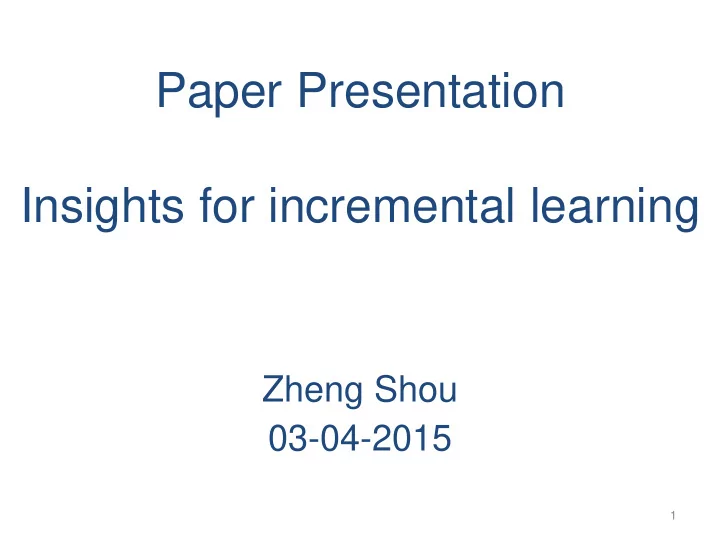

Paper Presentation Insights for incremental learning Zheng Shou 03-04-2015 1
Overview 1. Previous approach: Xiao, T., Zhang, J., Yang, K., Peng, Y., Zhang, Z. Error-Driven Incremental Learning in Deep Convolutional Neural Network for Large-Scale Image Classification . MM, 2014. 2. Insight for adjusting order of training points: Bengio, Y., Louradour, J., Collobert, R., Weston, J. Curriculum Learning , ICML 2009 3. Insight for designing loss function: Yi Sun, Yuheng Chen, Xiaogang Wang, Xiaoou Tang, Deep Learning Face Representation by Joint Identification-Verification , NIPS 2014 2
Previous approach ● Xiao, T., Zhang, J., Yang, K., Peng, Y., Zhang, Z. Error- Driven Incremental Learning in Deep Convolutional Neural Network for Large-Scale Image Classification. MM, 2014. ● What is incremental learning for CNNs? ● We have A CNN trained for old classes ● A new class coming in with training data ● Goal: Grow CNN incrementally. Comparing with training all classes from scratch, we want to 1. speed up training procedure; 2. Improve accuracy on new class; 3. Keep performances on old classes 3
Previous approach ● Approach 1: one-level expansion ● Flat expansion: add new classes nodes in last layer ● Copy weights of L0 to L0’ ● Randomly initialize weights between new classes nodes and the second last layer ● Use training data of new class to train L0’ 4
Previous approach ● Approach 2: two-level expansion ● Do one- level expansion first to obtain L0’ ● Partition old and new classes into several superclasses ● Do one-level expansion for each superclass, just in last layer only include old and new nodes in this superclass ● Training: train each networks separately ● Testing: decide superclass first and then its fine-label 5
Insight for adjusting order of training points ● How to leverage similarity of old class and new class? ● Bengio, Y., Louradour, J., Collobert, R., Weston, J. Curriculum Learning, ICML 2009. ● Motivation: Humans learn much better when the examples are not randomly presented but organized in a order which first illustrates easy concepts, and gradually more complex ones. ● Basic idea: construct training points easier to learn - starting from data that is easier to learning, and ending with the target training data distribution 6
Curriculum Learning ● Learning deep architectures o Non-convex optimization problem o Many local minima o Target dataset - black curve o Easy training dataset - red curve, more smooth o Reach better local minima 7
Curriculum Learning ● Experiments on shape recognition: The task is to classify geometrical shapes into 3 classes (rectangle, ellipse, triangle) Basic Target ● 3-hidden layers deep net ● Use two stage curriculum: Easy Easy Easy Target Target Target 8
Curriculum Learning ● Results: ● Vertical axis: error rate ● Horizontal axis: switch epoch (#epochs training on easy) ● Each box corresponds to 20 random initializations ● As switch epoch increasing, the final accuracy improves ● Imply that curriculum learning helps deep nets to reach better local minima 9
Insight for adjusting order of training points ● How to use curriculum to leverage similarity of old class and new class to help incremental learning? ● Model the similarity between new class and old similar classes as one part of the easiness 10
Insight for designing loss function ● Yi Sun, Yuheng Chen, Xiaogang Wang, Xiaoou Tang, Deep Learning Face Representation by Joint Identification -Verification, NIPS 2014 ● Identification - Enlarge difference between different classes Person 1 Person 2 ● Verification - Decrease difference among same classes Person 1 Person 1 11
Insight for designing loss function ● Yi Sun, Yuheng Chen, Xiaogang Wang, Xiaoou Tang, Deep Learning Face Representation by Joint Identification -Verification, NIPS 2014 ● Identification loss - maximize difference between training data of different classes, basically using softmax loss ● Verification loss - minimize difference of extracted features at second last layer among training data of same classes 12
Insight for designing loss function ● In incremental learning, when training coarse network and fine networks, also use Identification loss + λ * Verification loss ● Identification loss - maximize difference between training data of different classes, basically using softmax loss → This is more important when training coarse network, set λ a bit smaller ● Verification loss - minimize difference of extracted features at second last layer among training data of same classes → This is more important when training fine network, set λ a bit larger 13
Thank you! 14
Recommend
More recommend